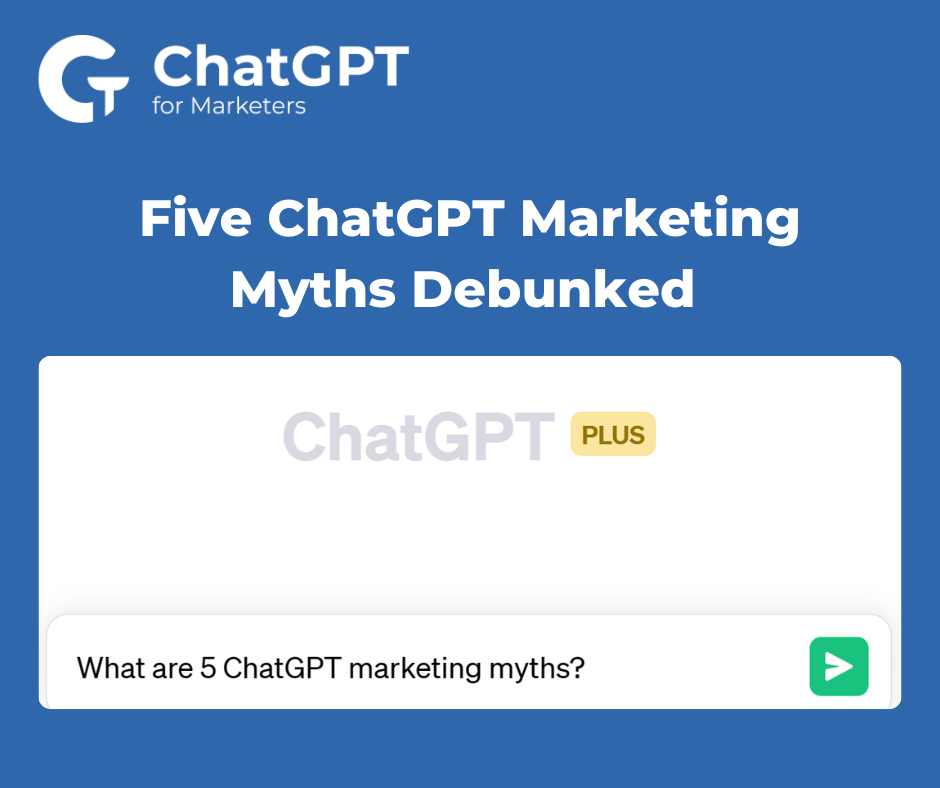With the media’s spotlight on ChatGPT and the surge in its adoption by marketers as a vital component of their toolkit, many myths and half-truths have inevitably emerged.
This blog post separates fact from fiction by tackling five ChatGPT marketing myths.
Myth 1 – ChatGPT Can Replace Human Marketers
Fearmongers and luddites continue to push the myth that ChatGPT will replace human marketers.
It might seem plausible. After all, ChatGPT can generate compelling content, automate customer interactions, and perform tasks in a fraction of a human’s time.
ChatGPT is a powerful tool but lacks the creative instincts, strategic insight, and real-world understanding human marketers possess.
It cannot interpret nuances in the same way a human can, nor does it have the ability to comprehend context outside of the information it has been trained on or convey the personality of a human marketer.
ChatGPT shines in its capacity to assist, streamline workflows, and generate content based on the inputs it’s given.
However, the inspiration for these inputs, the strategy that decides what information is relevant, and the human touch that truly knows how to connect with customers are uniquely human.
In essence, rather than seeing ChatGPT as a threat to their jobs, marketers should view it as an ally. To paraphrase a famous marketer, ChatGPT will not replace marketers; marketers using ChatGPT will replace those that are not.
 Myth 2 – ChatGPT Understands Context Just Like Humans Do
Myth 2 – ChatGPT Understands Context Just Like Humans Do
The notion that “ChatGPT understands context just like humans do” is an appealing thought, as it paints a picture of seamless, human-like conversations and content.
But the reality is a tad different.
While ChatGPT is incredibly sophisticated and can generate remarkably coherent and contextually relevant responses, it doesn’t truly “understand” the context in the human sense.
ChatGPT does not possess beliefs, feelings, or a worldview (although some bias may creep in) It is an artificial intelligence model that generates responses based on patterns in the data it was trained on.
It can’t grasp subtleties of language and context that come naturally to humans, such as sarcasm, culture-specific references, or an individual’s personal history.
That doesn’t mean it’s not useful.
ChatGPT can produce highly relevant, engaging, and valuable content when guided effectively. It can mimic human conversation convincingly and even infuse empathy into its responses (based on the patterns it learned during training). The key is knowing how to guide it effectively, understanding its limitations, and applying its outputs informally.
While ChatGPT can help generate contextual responses, it’s important to remember that it’s not truly comprehending the context in the way humans do.
It’s a nuanced but critical distinction to remember when implementing ChatGPT within your marketing strategy.
Myth 3 – The Longer and More Detailed the Prompt, the Better the Output
When interacting with ChatGPT, there’s a persistent myth that “The longer and more detailed the prompt, the better the output.”
Sounds logical that the more information you provide, the better the AI understands and responds.
While providing some context can help guide ChatGPT’s responses, an overlong or overly complex prompt can sometimes result in less satisfactory outputs.
ChatGPT generates responses based on patterns it learned during training, and it’s bound by limits to how much it can process in both the prompt and the response.
The real trick to receiving useful output from ChatGPT lies in the art of crafting clear, concise, and targeted prompts.
It’s a bit of a balancing act, figuring out how to give just the right amount of information in your prompts.
But once you’ve mastered this skill, you’ll find it’s a game-changer in efficiently leveraging ChatGPT for your marketing needs. Remember, less can indeed be more when it comes to ChatGPT prompts!
Myth 4 – ChatGPT Can Independently Make Strategic Marketing Decisions
With the name artificial intelligence, there is a belief that ChatGPT can make strategic marketing decisions independently.
While ChatGPT is a powerful tool capable of quickly processing large volumes of data and providing insightful suggestions, it is a language model and not accurate intelligence.
What it can do, however, is aid decision-making.
It can generate content based on specific prompts, provide suggestions based on patterns in its training data, and even simulate brainstorming sessions or prospective customer interactions.
These capabilities can offer valuable insights to inform your strategic decisions.
But the ultimate decision-making power should rest with human marketers who understand the complexities of the market, the specific nuances of their business, and the ever-changing dynamics of customer behaviour.
Therefore, rather than considering ChatGPT as a decision-maker, consider it a decision-support tool. It’s there to enhance and streamline your processes, not to take the reins out of your hands.
Myth 5 – ChatGPT Is Only Useful for Content Creation in Marketing
Content creation is one of the most popular applications of ChatGPT, but limiting it to this underestimates its potential.
ChatGPT’s capabilities extend far beyond just content creation. Its usefulness encompasses a wide range of tasks within the marketing sphere.
For instance, it can help market research by synthesising and summarising information. It can act as a brainstorming partner, providing fresh ideas for campaigns or content themes.
It can help automate certain aspects of customer service, quickly responding to customer inquiries.
Furthermore, with some creativity, ChatGPT can even be used for tasks such as email drafting, social media post generation, and ad copywriting.
It can be a handy tool for language translation in global marketing, and it can assist in competitor analysis by producing comparative reports based on provided data.
In a nutshell, the potential applications of ChatGPT within the marketing domain are as diverse as your imagination allows.
By thinking beyond content creation, marketers can discover new and innovative ways to make ChatGPT an even more integral part of their toolkit.